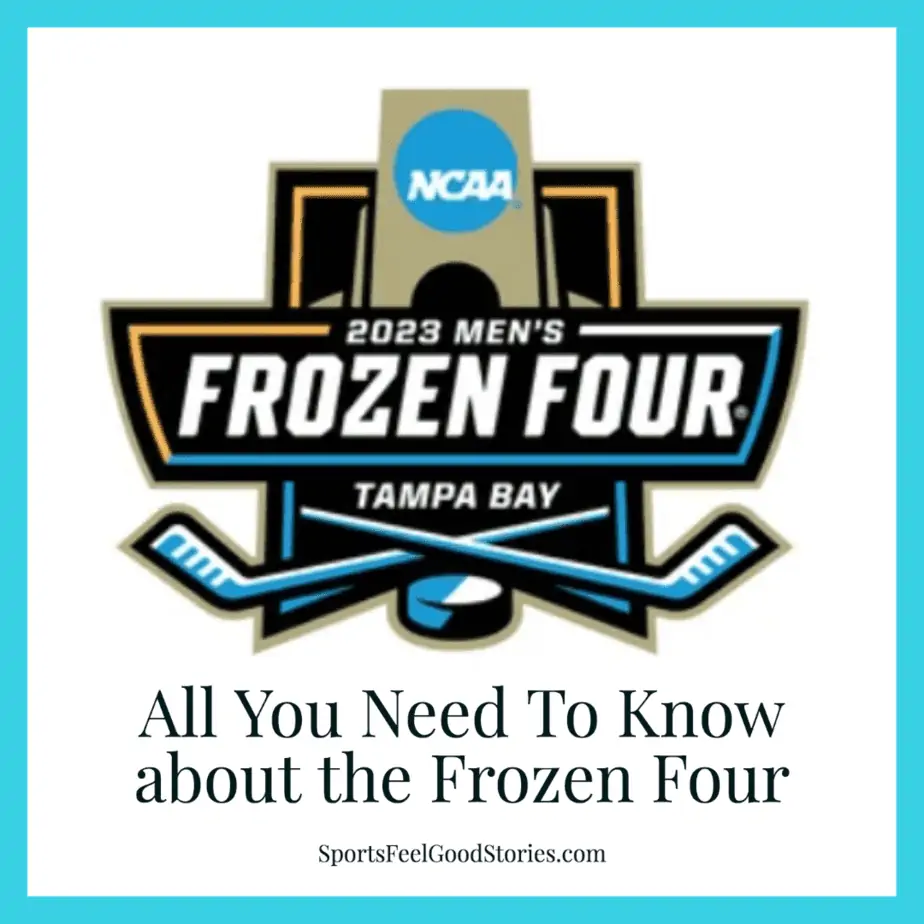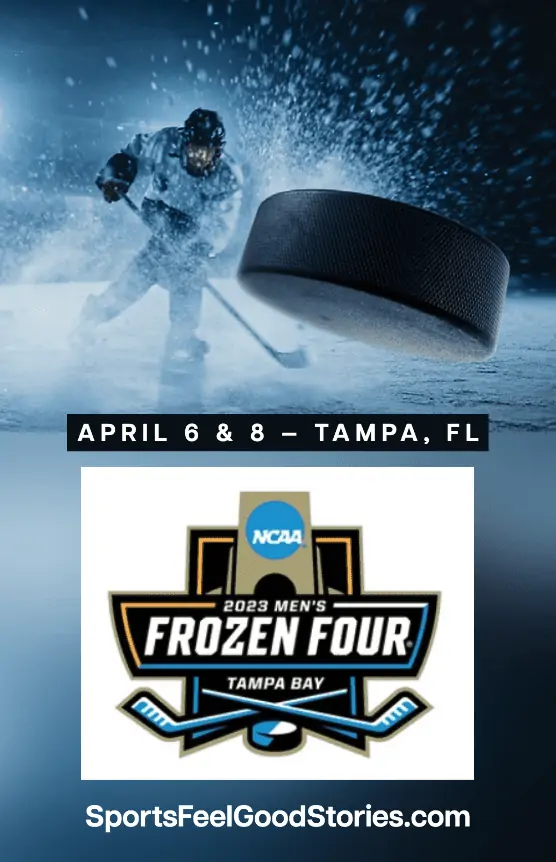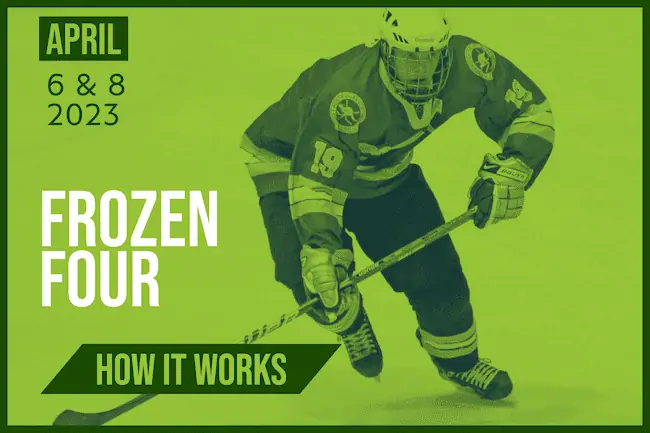I love hockey. Just knowing that when the leaves start to change, NHL hockey is just around the corner, I get thrills. Thankfully, hockey isn’t restricted to the NHL. We get to watch more hockey with events such as the Frozen Four.
If you’re a fan like me of all things hockey, you’ll want to know more about this exciting tournament. So, let’s dig in.
What is the Frozen Four?
Every year the NCAA Men’s Ice Hockey Division I has a tournament. After 12 of the 16 participating teams have been eliminated, the tournament is left with the final four teams. These last four teams are known as the Frozen Four.

History of the Frozen Four
The first Frozen Four took place in 1948. Over a decade, the three-day event occurred in Colorado Springs, Colorado. In 1958, the location was no longer fixed and would rotate NHL rinks throughout the United States.
The very first winner of the tournament was Michigan which beat Dartmouth by a score of 8-4. Despite its long history, the semifinals and finals were only named Frozen Four in 1998. This name plays on the famous Final Four in the NCAA Division Men’s Basketball tournament.
In 1988, the tournament expanded to include 12 teams from its original eight. Then, in 2003, the tournament expanded to include 16 teams, where it currently stands. Denver and Michigan are tied for most NCAA hockey championships at the Division I level with nine wins each.
When is the Frozen Four?
The 2023 men’s tournament takes place on April 6 and 8. The Women’s Frozen Four will be played on March 31 and April 2, 2023.
The Frozen Four takes place each year during the spring season or during a weekend in April. The only year that the Frozen Four did not take place was 2020 due to the COVID-19 pandemic.
See How Long Is A Hockey Game?
Where is the Frozen Four played?
The 2023 Men’s Frozen Four will be played in Tampa on April 6 and 8. The Women’s Frozen Four will be played in Dallas, Texas, on March 31 and April 2, 2023.
Since 1958, the location of the Frozen Four has changed. Buildings will put in a bid to host the Frozen Four. As the games take place in an NHL rink, the NHL team who also plays there must be on board, knowing they will lose their building for a few days.
But any NHL team will tell you that they bid hard on being a host when they bid. Bidding from the building and community typically starts in August, and the decision is made in October of the same year.
The next Frozen Four tournaments will take place in Tampa (2023), St. Paul (2024), St. Louis (2025), and Las Vegas (2026).

How Does a Team Qualify for the Frozen Four?
Well, it isn’t easy, and here’s why. Recall that above I stated the tournament includes 16 teams. First, 61 institutions sponsor Division I Men’s Ice Hockey teams. All these teams are eligible to compete.
Six of these teams qualify by winning one of the six conference tournaments. These conference tournaments include:
- Atlantic Hockey
- Big Ten
- ECAC
- Hockey East
- NCHC
- WCHA
These winners earn an automatic bid to participate as one of the 16 teams. The remaining ten teams are selected on an at-large basis, based on the following ten best teams who didn’t receive automatic qualification. But how do they decide who the following best ten teams are?
See Hockey Parents: Tips for Being Chill.
They are ranked by a computer, of course. This ranking system has three criteria that compare the 60 Men’s Division I teams. The three criteria are divided into the following:
- Record against common opponents
- Head-to-head record
- Rating Percentage Index (RPI)
So, a team earns a point for having a better record. Second, they make a point for each win in a head-to-head play. The last criterion is divided into a winning percentage and an opponent’s winning percentage.
Bonuses can also occur by beating teams in the top 20. They also score home and away wins differently. Lastly, the deciding committee may also base its decision on availability for the tournament. The RPI works to help break ties within the first two criteria.

How Does the Seeding Work for the Frozen Four?
Now that the 16 teams have qualified, four groups must be created from their rankings. The top four teams are given the number one seed spot in each of the four brackets. The next top four teams are seeded second in each bracket. This is followed by the next top four, seeded third, and the last top four teams seeded fourth.
Each bracket is placed at one regional site. If one of the teams is a host, they will be placed in the bracket that will play in their regional site, giving them a home-team advantage. Now, here’s where it gets a bit tricky.
Although they prefer that first-round conference matchups are avoided, they have to consider the integrity of the bracket. Two teams from the same conference may be shuffled around to avoid this matchup.
But if five or more teams come to the championship from one conference, a matchup is unavoidable, and the integrity must be considered. They won’t mix up the seeding to avoid this matchup. Lastly, if all top four teams make it to the Frozen Four, there is a contingency plan.
First, the number one seed will play the number four seed. Next, the number two seed will play the number three seed in the semifinals. Sufficiently confused yet? Don’t worry; I promise you, when you watch it, the commentators will all explain it as it unfolds.
Before we get to the Frozen Four, each bracket will compete at Regionals. This is an exciting battle of three games, each a single-game elimination. The winning team from each of the Regionals advances to the Frozen Four.
Want to see what the fuss is all about? Catch the 2022 tournament’s most notable goals in the following clip.
See Rink Size.
Notable Goals Video
Notable Frozen Four Powerhouses
It’s safe to say that since Denver and Michigan are tied for most NCAA hockey championships, each is a powerhouse. Michigan alone has made the Frozen Four 26 times. Second in visits to the championship games is Minnesota with 22 visits and Denver with 17.
One might also want to consider college hockey players drafted for the NHL. To that end, drafted in the first round, even. According to my research, 185 players have been drafted from college hockey players.
From this, it is no surprise that Michigan stands on top with 30 first-round picks. In second place is Minnesota, with 22 players. Michigan Wolverines have garnered players such as Quinn Hughes, Max Pacioretty, and Zach Werenski.
Beyond these players, they have produced over 16% of all first-round picks in NHL history. Finally, in 2021 they had two teammates plucked as the top two overall picks. The top five schools for NHL picks are Boston College, Boston University, and North Dakota.
Typical Attendance
Regardless of the actual numbers, attending a Frozen Four game is always full of excitement. But if you are a stats person, I’ve got some numbers for the curious.
- In 2010, at Ford Field, Detroit 37, 592 hockey fans attended the Boston College versus Wisconsin match for the highest-record attendance.
- In 2010, at Ford Field Detroit 34, 954 hockey fans attended the Boston Collage versus Miami and Wisconsin versus Rochester games.
- The following 13 games round out the top 15 with an average of 18, 000 – 19, 000 attendees
Frozen Four Fun Facts
Here are a few bonus facts relating to NCAA hockey.
1.) The NCAA is the National Collegiate Athletic Association, a non-profit organization that manages the athletic programs of colleges and universities across North America.
2.) The NCAA championship of women’s ice hockey began in 2001 (yes, there is a women’s championship too)
3.) While the men have six conferences, the women have five – College Hockey America, ECAC, Hockey East, New England Women’s Hockey Alliance, and Western Collegiate Hockey Association
4.) NCAA Hockey Division I is different from NCAA Hockey Division III (Want to know more? Check out the video below for an in-depth explanation)
5.) Division II is more like a hockey scholarship, with no Division II Championship for men or women.
6.) Colorado College’s Carl Lawrence and Michigan’s Gil Burford each scored five goals in one Frozen Four game.
7.) Minnesota’s John Mayasich had seven points in one Frozen Four game back in 1954 against Boston College.
Final Thoughts
There you have it, folks. Everything you need to know about the Frozen Four in College Hockey. Whatever hockey you happen to follow, it’s always a fun time. And selecting a favorite team is all part of the fun. Why not check it out and see who catches your interest?
By Danielle L’Ami
Danielle is a Canadian writer, a die-hard Habs fan, and the champion of her fantasy hockey league.
Overtime
You are on our What is the Frozen Four in College Hockey page.
You might like:
